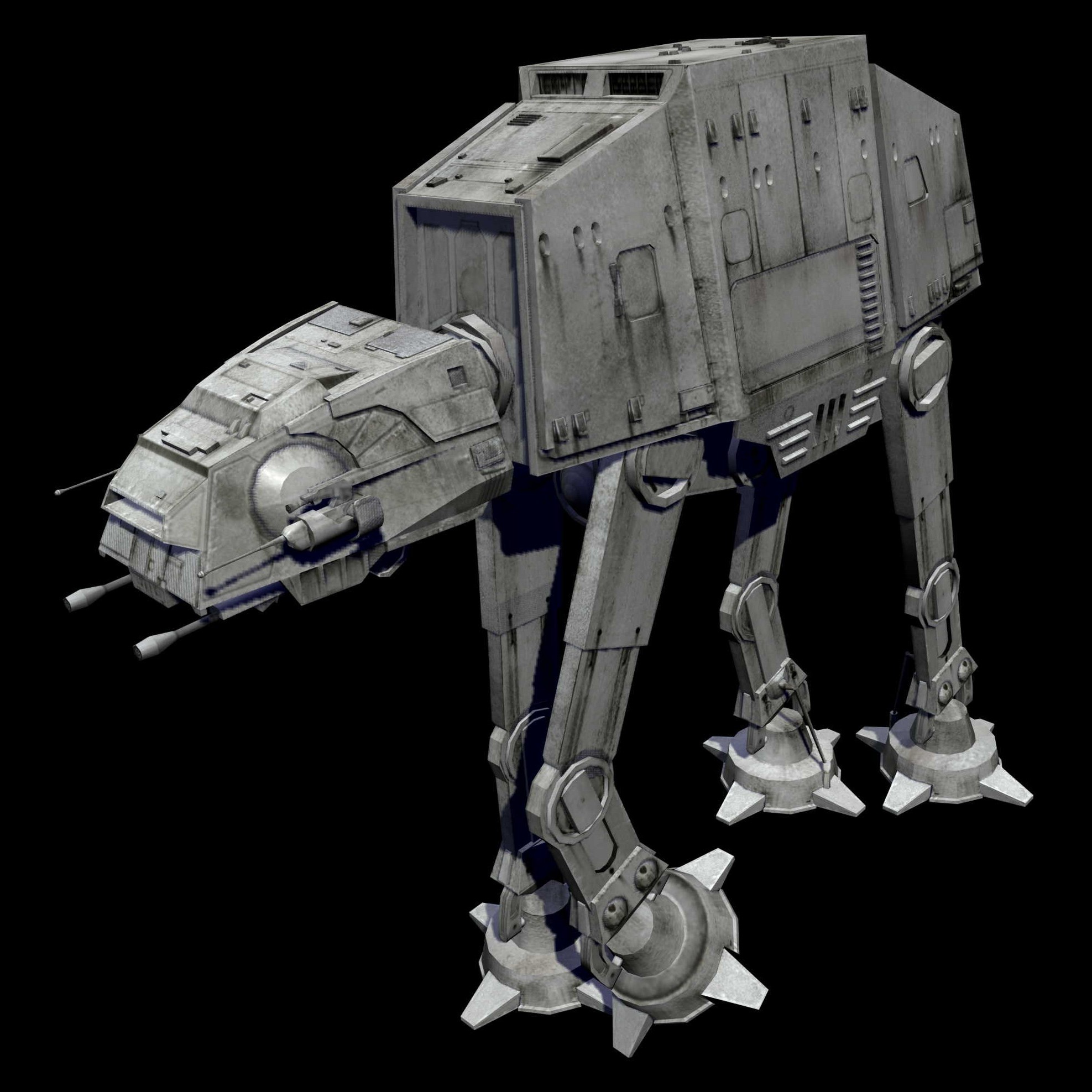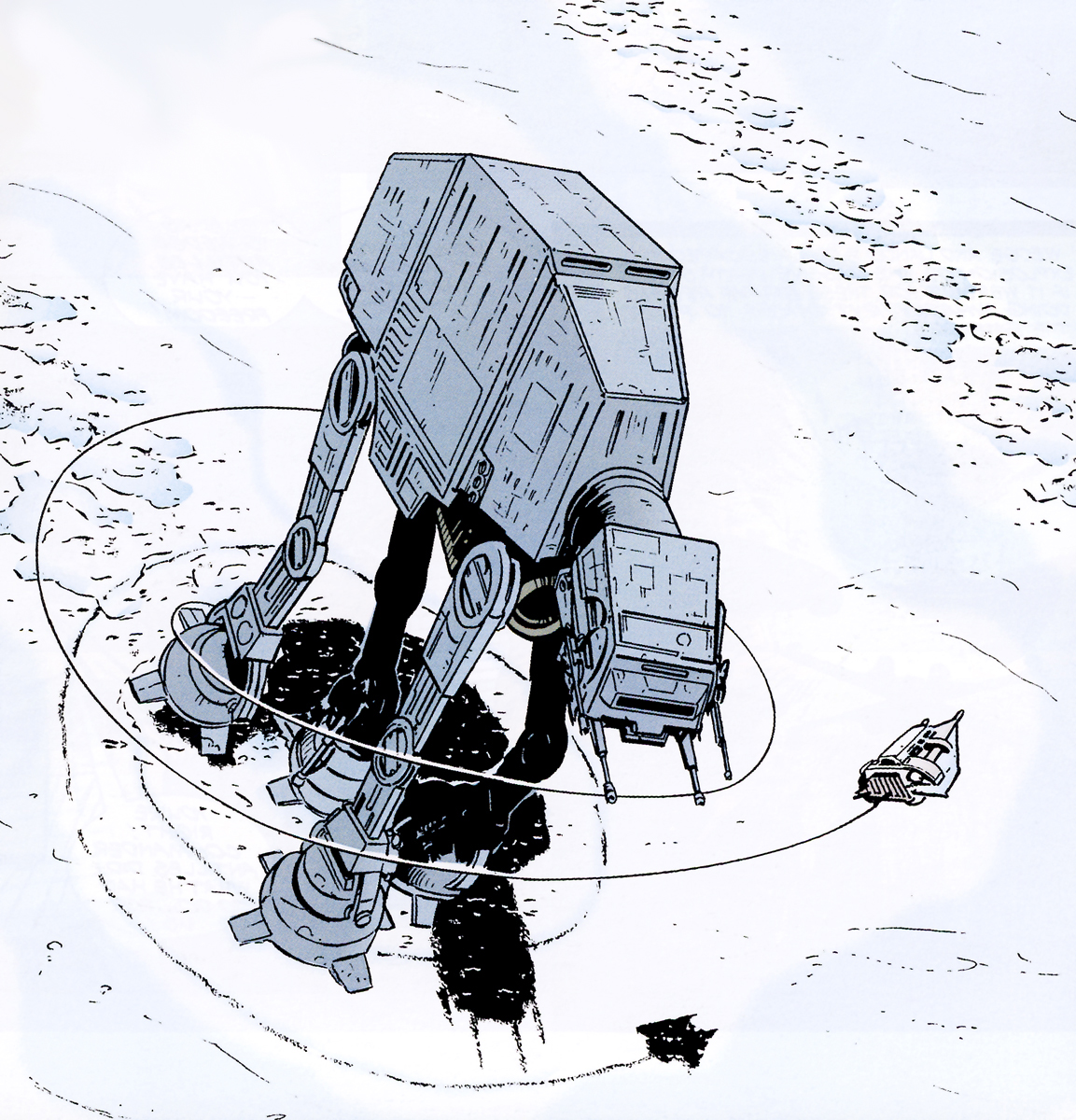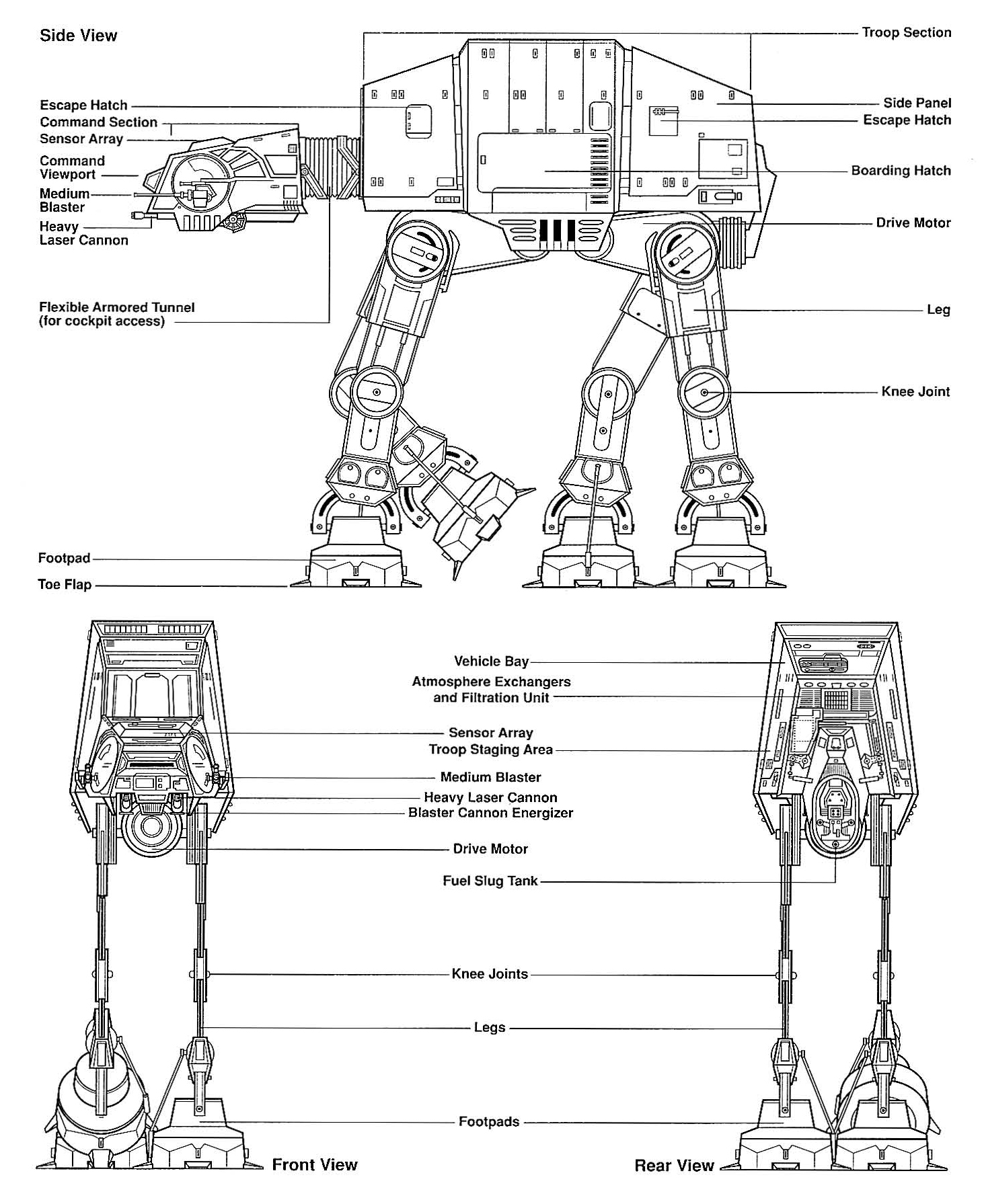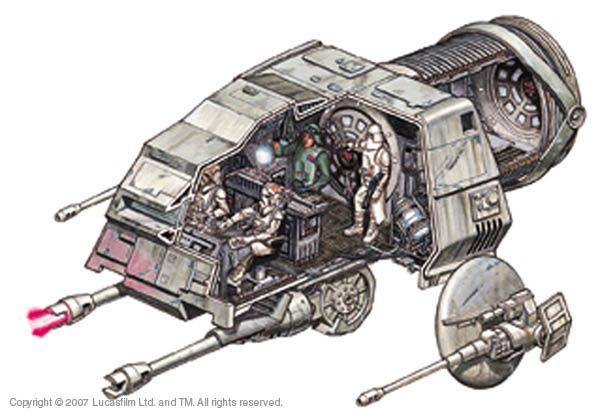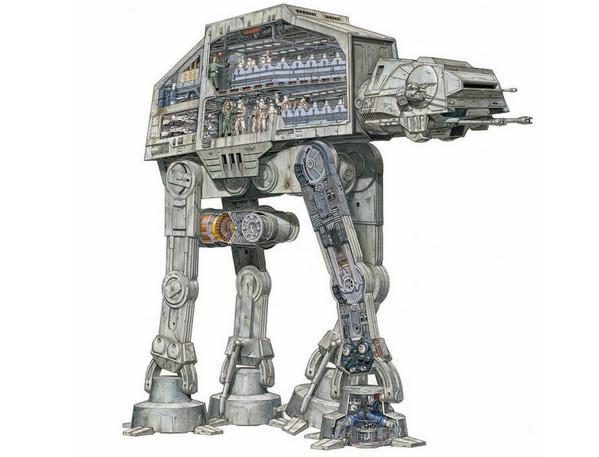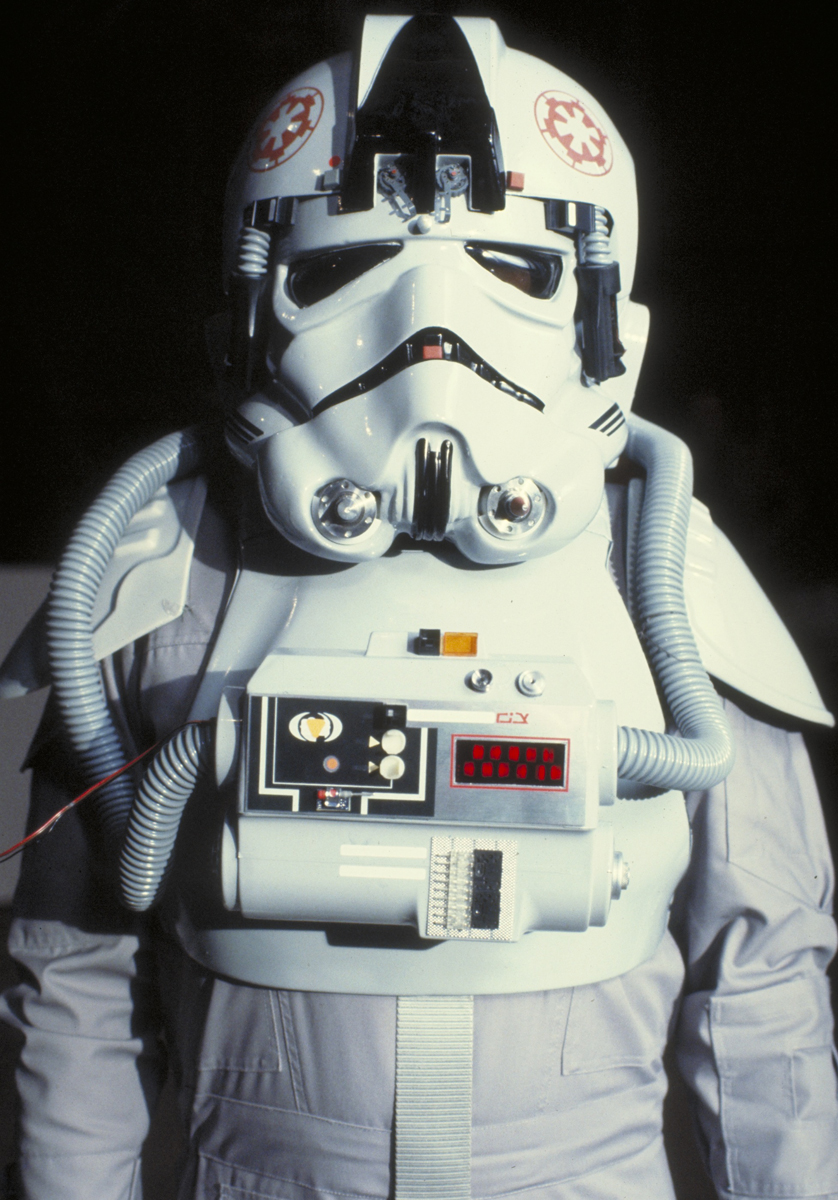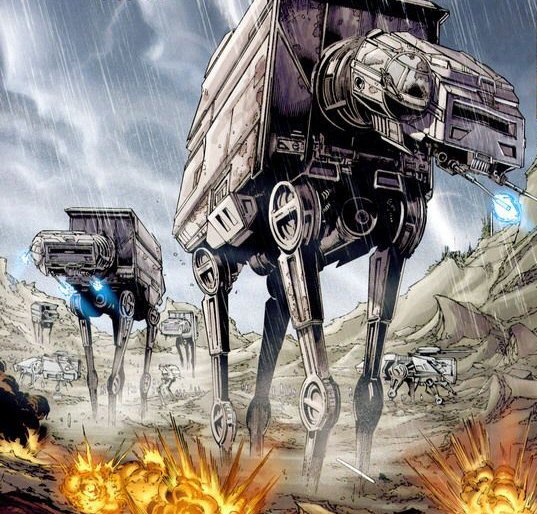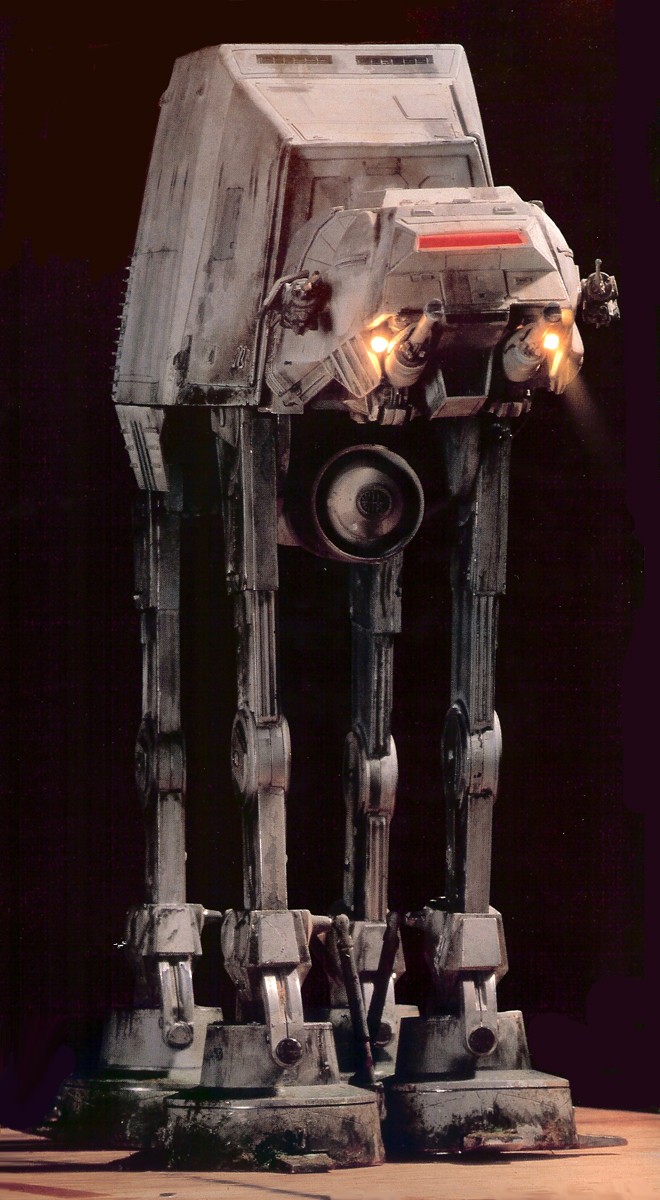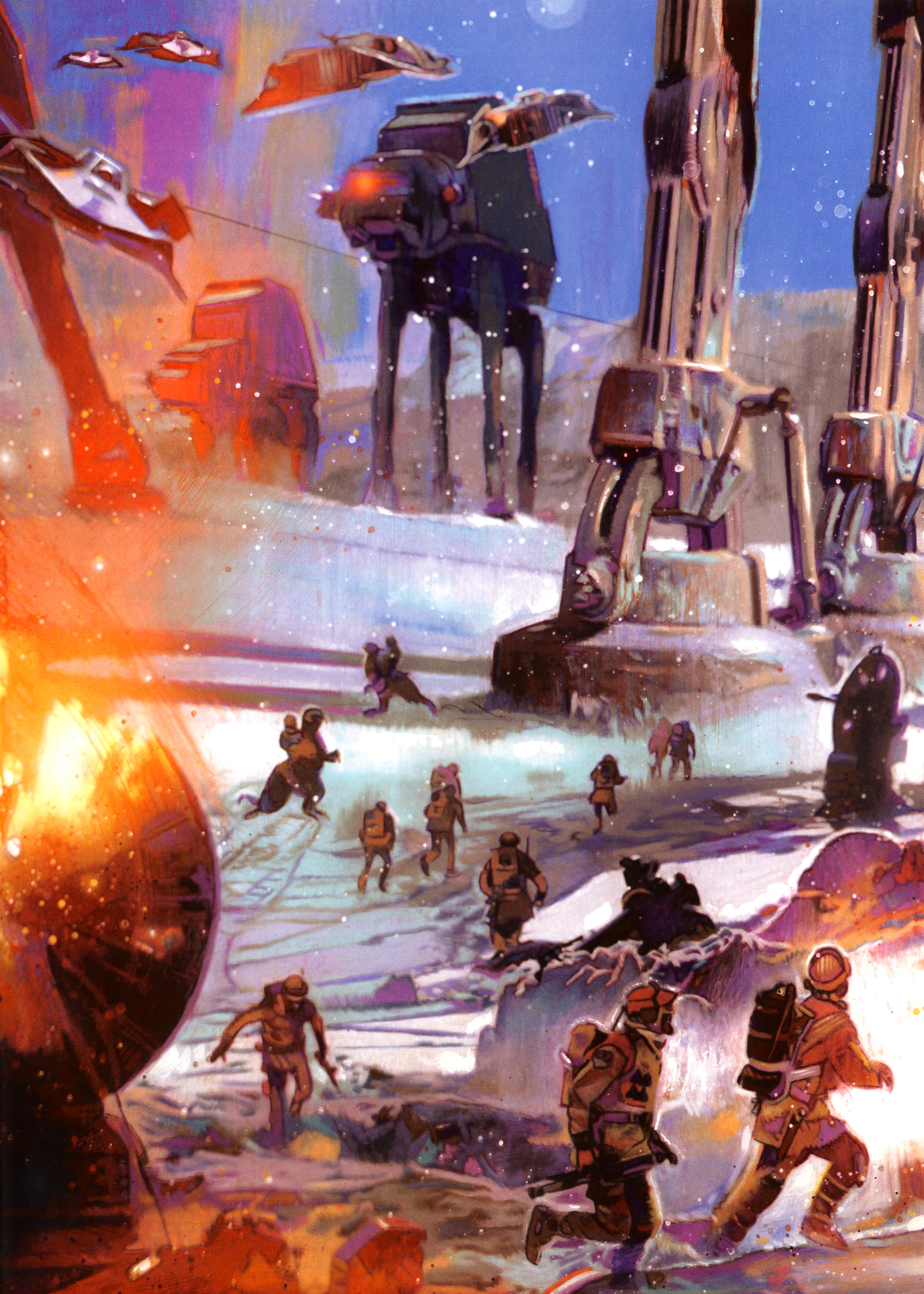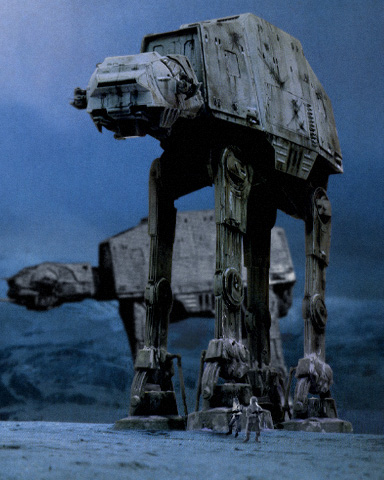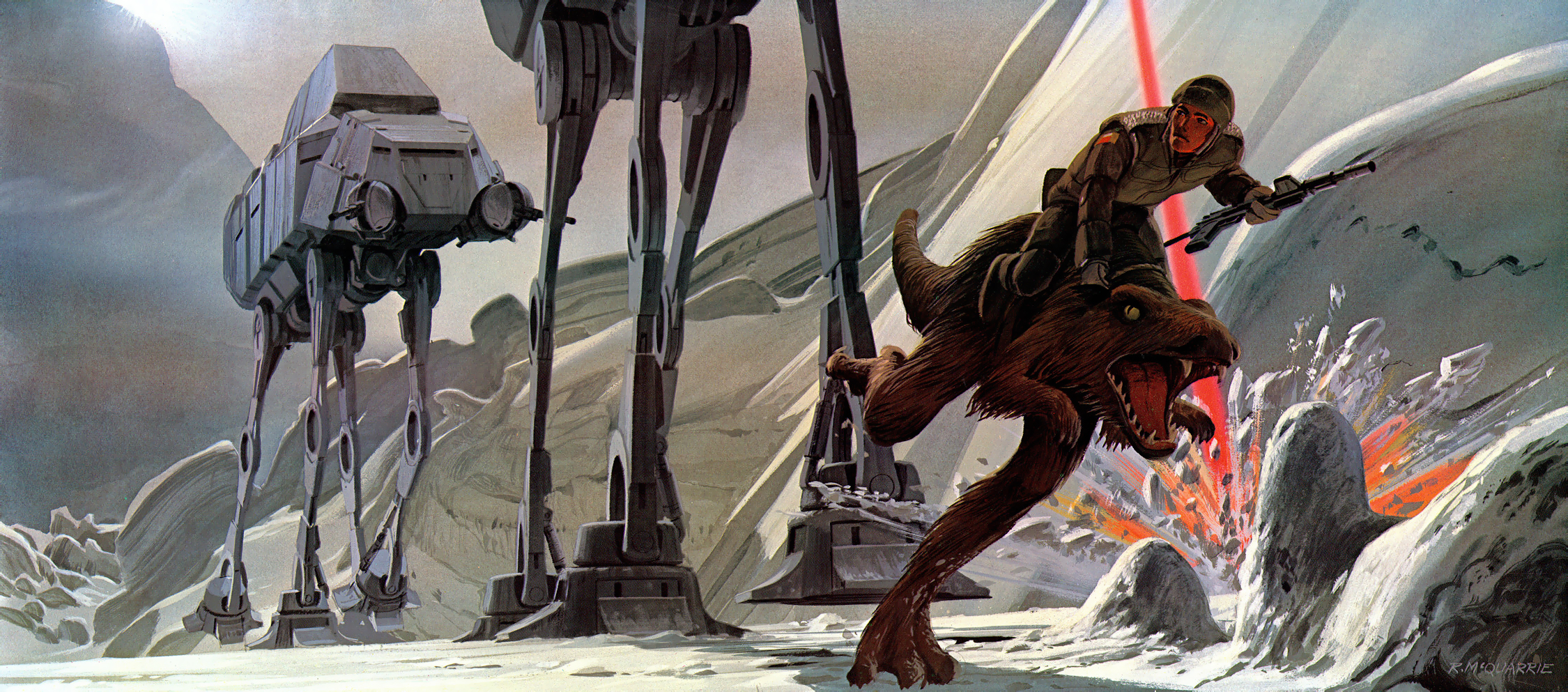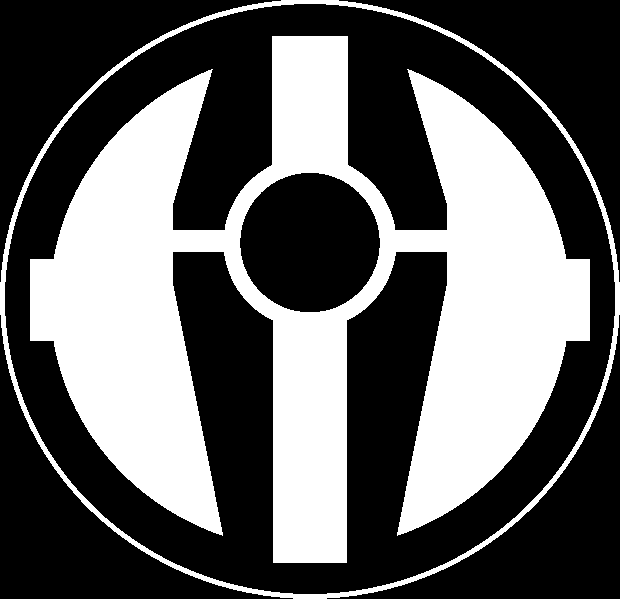
Transport (AT-AT).

| "We had the Battle of Gormen won, until the AT-ATs arrived. They came out of the fog and ripped apart the front lines. The locals ran in terror, but the experienced soldiers surrendered. We knew that you can't outrun an AT-AT." - Major Bren DERLIN, Alliance to Restore the Republic (Rebel Alliance) field commander, quoted in The New Essential Guide to Vehicles and Vessels |
Description
| "Lookit 'em, boss! Great, big, fat gray targets!" "I know, Zev, but they've got a long reach." - Radio communiqu'e between Zev SENESCA and Luke SKYWALKER during the Battle of Hoth. |
Serving as the "head" of the mechanical walker was a movable command section containing the command cockpit, with room for the commander, pilot, and gunner. The command section housed all of the AT-AT's weapon systems, as well as holographic targeting systems allowing the gunners a 360-degree view of their position. The cockpit was also equipped with a holographic projector for purposes of external communication. Forward visualization was supplied by a glowing red command viewport. The head could rotate as much as ninety degrees right or left and thirty degrees up or down for an expansive field of fire. Positioned above and below the command section was the walker's sensor array and blaster cannon energizer, respectively.
The command head was attached to the trapezoidal armed body section by a flexible armored tunnel, allowing cockpit access from the rest of the machine. The AT-AT's troop section could typically carry five speeder bikes, up to forty troops normally comprising Imperial stormtroopers or Imperial land assault troopers in a double-tiered passenger section, and heavy weaponry, such as E-web heavy repeating blasters. The AT-AT could also variably hold two All Terrain Scout Transports in lieu of soldiers in a rear vehicle bay, though they required partial disassembly to fit inside. Housing the troop section were two large side panels; each one held an escape hatch. The rear panel also housed the troop staging area. Positioned in the center of the body section was a rectangular boarding hatch with sliding ramps where the AT-AT's complement of troops loaded and disembarked. An AT-AT unloaded its troops by kneeling to three meters above ground level until the boarding ramp could extend outward. Individual stormtroopers could also be deployed rapidly by rappelling cable.
Below the troop body section were two immense Kuat Drive Yards FW62 compact fusion drive systems that, in conjunction with the walker's four giant heavily-reinforced legs, propelled the AT-AT forward at a top speed of sixty kilometers per hour. However, this maximum rate was achievable only on a flat, stable terrain. At the rear of the drive motors were the walker's three fuel slug tanks, connected to the drive motors, that powered the massive machine. The AT-AT's rear also included atmospheric exchangers and a filtration unit to regulate the interior living conditions. The walker's legs were supported by massive durasteel footpads with impulse terrain sensors, supplemented each by toe flaps, that could crush obstacles in its path with little effort, effectively helping the AT-AT to live up to its name. The legs did, however, require constant maintenance and repair. As the titanic walker marched down the battlefield, its heavy, stomping feet would cause the ground to shake, demoralizing the enemy before they were even engaged.
The AT-AT's formidable offensive capabilities were supplied by dual, chin-mounted Taim & Bak MS-1 fire-linked heavy laser cannons for slower, more cumbersome targets and two fire-linked medium repeating blasters mounted on each side of the head designed for lighter, agile targets. The two sets of weapons could be independently rotated in order to engage multiple targets at once. However, the AT-AT head, which could move between a range of left, center, and right firing arcs, could only rotate one fire arc per heavy laser volley. The walker's strong external durasteel armor was virtually impervious to all but the heaviest of artillery weapons.
| "Outpost Beta here. I have a visual now. These things look like... animals. They're huge, maybe ten, fifteen meters high, four-legged, and their heads move. They're made out of metal. They have extremely heavy armor and armament. I count six of 'em so far." - Maren Kelsome of Outpost Beta, in a radio communiqu'e during the Battle of Hoth. |
AT-ATs were typically deployed for ground assault from orbit by large dropships. Walkers stationed within larger warships, such as the Executor-class Star Dreadnought, were delivered to planetary surfaces within Incom Y-85 Titan dropships, capable of carrying four 22.5-meter AT-ATs. Smaller ships, such as the Imperial-class Star Destroyer, deployed single walkers via the Theta-class AT-AT barge. Other designs, including the Telgorn Corporation Warlord Dropship, were capable of delivering a platoon of four walkers.
Modified Variants
The Empire utilized several modified variants of the standard AT-AT design for purposes of fitting certain mission profiles in specific environments. The walkers used at the Battle of Hoth in 3 ABY nicknamed "snow walkers" were specially designed with heat circulation systems, de-icing controls, and energy efficient environmental controls.
The AT-AT "dune walker" was a desert terrain walker fitted with Sienar Fleet Systems z23 heat dissipation units; while the Aquatic Terrain Armored Transport, known as the AT-AT "swimmer," was a repulsorcraft cousin of the standard model. There was also the All Terrain Ion Cannon, a long-range artillery gun mounted on an AT-AT chassis.
History
Clone Wars Origin And Development
AT-ATs were first designed and assembled by Kuat Drive Yards during the Clone Wars. They were evolved from the AT-TE walkers first employed in the Battle of Geonosis, as well as the AT-PT.
The first-generation AT-AT walkers saw their debut during the Battle of Jabiim, later on in the Clone Wars. During this battle, the overwhelmed Confederacy forces were annihilated by them. Their significance waned when the walkers were slowed down by the muddy surface on the planet, making it easier for the enemy units to bring them down. At some point, AT-AT walkers managed to fall into the hands of the CIS, with at least one unit being kept in a research facility on the Separatist world of Diado.
During the Wars, wheeled tanks like the A5 and A6 Juggernauts were preferred over both the AT-AT and the AT-HE, due to the decreased ground pressure of wheeled vehicles over legged ones.
Imperial Refinements
During the time of the Forgotten Empire, AT-ATs were not completely forgotten, as a later-generation model participated in the Battle of Orion IV. After the Battle of Yavin, it was Maximilian Veers that fully resurrected the concept, bringing the AT-AT into full Imperial service, deployed on a wide array of worlds in the following months, including Corellia, Chandrila, and Gormen. Nearly three years after the Battle of Yavin, Veers neared completion on a superior model while on Zaloriis. This was nicknamed the "Dune Cow". With the prototype Blizzard I, constructed at Camp Culroon, Veers assaulted the planet's capital when Zaloriis declared their affiliation with the Rebellion.
At least one AT-AT was used at the Battle of Boz Pity. The AT-AT was unknowingly steered into a trap set by Renegade Squadron; a detpack was used to blow up a hidden cache of explosives, and the huge explosion toppled the machine. However, the battle was ultimately a victory for the Empire.
At the Battle of Hoth, the Empire used the Blizzard Force AT-ATs to assault the Rebel's Echo Base, as it was protected from above by an energy shield. Due to their weight, and the unstable terrain they were traversing, a few were lost before the battle even began. General Maximilian Veers commanded the ground forces and advanced on the shield generator, decimating
Faced with such forces, Luke Skywalker employed a strategy earlier devised by himself and strategist Beryl Chiffonage to disable the walkers: his team of snowspeeders would use their magnetic harpoons and tow cables to entangle the walkers' feet, causing them to fall. Wedge Antilles and his gunner Wes Janson managed to disable one walker this way. Luke destroyed a second by cutting a hole in it with his lightsaber and tossing in a concussion grenade.
Dash Rendar was able to bring down a third through unknown means. Another AT-AT that closed on Echo Base was destroyed by Renegade Squadron, which used particle cannon turrets to destroy the war machine. (The dangers of AT-AT walkers toppling was discovered by an Imperial Cadet named Davin Felth, but the oversight was not corrected by Colonel Veers prior to deployment.)
Despite these small successes, they were ultimately insufficient to turn the tide of the battle, and the Battle of Hoth was one of the most devastating losses for the Rebels in the entire Galactic Civil War. The AT-ATs succeeded in destroying the shield generator, thereby allowing the main Imperial force to land and attack Echo Base. The AT-ATs would go on to devastate the Rebel defenses.
At least one AT-AT patrolled the garrison base on the forest moon of Endor, but had no impact on the battle there, as AT-ATs were limited in their range by the dense foliage of the moon. As a result, smaller vehicles such as AT-STs saw far more use. An AT-AT was originally going to be used in the Battle of Endor, but it ended up becoming crippled by Renegade Squadron, resulting in portions of the Galactic Empire trying to fix it.
Beyond Endor
Sometime after the Battle of Endor, the Empire replaced the AT-AT's lasers and blasters with light turbolasers, easily capable of defeating many highly protected defensive weapons emplacements.
By 9 ABY, Nomad City on Nkllon was a mining operation owned by Lando Calrissian. The city was built from a Dreadnaught-class heavy cruiser mounted on top of 40 captured AT-ATs to move the city constantly away from the day side of Nkllon and prevent it from being destroyed by intense radiation of Nkllon's daytime. However, the city was damaged and then abandoned, and Nomad City and its AT-ATs were destroyed by the intense radiation.
During the reborn Emperor Palpatine's insurgency in a clone body from 10 ABY to 11 ABY, the Empire developed a new variant of the AT-AT that was equipped with the most powerful Imperial turbolasers and the new X-80 power cells. These were deployed during an attack on New Alderaan. During the battle, they vaporized many buildings, gun emplacements, and starfighters.
Following the Galactic Civil War, AT-ATs were also used by the New Republic, the Galactic Federation of Free Alliances, and various other governments. During the Yuuzhan Vong War, the Myrkr strike team found one of these vehicles on the Yuuzhan Vong Koros-strohna Baanu Raas in 27 ABY. AT-ATs were also deployed by the Galactic Federation of Free Alliances during the liberation of Coruscant in 30 ABY. It is the predessesor of the All Terrain Armored Heavy Transport.
Critical Analysis
The AT-AT is truly an intimidating weapons platform- To the uninitiated. Being so tall, heavily armored, and heavily armed, they 'look' intimidating. At 37.5 MPH they can outrun a person on foot.
But to a more sophisticated force, such as the REF and the Rakatan Galaxy Defense Forces (and even most of the Regional Self-Defense Forces), the slow speed and limited maneuverability of the AT-AT makes it highly vulnerable. Additionally, the well-known design flaw in the legs that leave it susceptible to tripping makes it practically obsolete; Finally, the neck, it turns out, is hyper vulnerable to heavier blaster fire. Practically any crew-served or vehicle-mounted weapons system can penetrate the neck armor, at very least exposing the very delicate internal components to continued fire. More often, once a single round punches through the neck, multiple internal failures result in massive componentry failure, and this often results in cataclysmic system failure. In more than one case, the main reactor was observed to explode, though exactly why is still unclear as no Operations Data Recorder ("black box" in aero-spacecraft) has ever recorded that last moment. It is believed that the reactor suddenly spools out of control, consuming fuel at a prodigious rate. It's called the "Supernova Effect."
Now only a few groups use the AT-AT offensively, and not many use them defensively either. None use them by themselves, but as the "heavy hitter" of a formation consisting of at least 02 lighter ground platforms (such as the AT-PT) and 02 aerial platforms (such as the INT-4), and usually a much heavier formation. Not since the Battle of Endor (before the Dark Ages) has more than a dozen AT-AT's been deployed at the same time. Never has more AT-AT's been deployed at one time than at the Battle of Hoth (when over 100 were deployed).
The only faction to routinely deploy AT-AT's in numbers is the Palpatinian Order, who will load up 2 to 4 with troops and then have them land with their troops intact. A few dozen miles from the target, the troops are off-loaded and the AT-AT's themselves are either rounded up and returned to orbit, or if necessary abandoned. They do not get close enough to the front lines (or intended front lines) to come under fire.
The Geh 'Dai Order however has a couple thousand AT-AT's they have coverted to light duty starships with factor 8 FTL drives and heavy shielding; They delivered a few dozen to the UGC Army as well for evaluation purposes, but as Master REVADE blandly put it "We're actually happy to offload these junkers onto you, you're doing us a favor. You're taking the worst of our trash, you can have the whole damned lot as far as I care."
